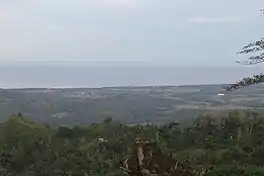Sultan Kudarat
Sultan Kudarat, officially the Province of Sultan Kudarat (Hiligaynon: Kapuoran sang Sultan Kudarat; Maguindanaon: Dairat nu Sultan Kudarat, Jawi: دايرت نو سولتان كودرت; Cebuano: Lalawigan sa Sultan Kudarat; Filipino: Lalawigan ng Sultan Kudarat), is a province in the Philippines located in the Soccsksargen region in Mindanao. Its capital is Isulan and the commercial center is Tacurong.
Sultan Kudarat | |
|---|---|
| Province of Sultan Kudarat | |
| Other transcription(s) | |
| • Jawi | سولتان كودرت |
 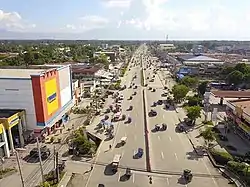   (from top: left to right) Palavilla road in Lutayan, Tacurong City, Aerial view of Lebak, and Sultan Kudarat Provincial Capitol in Isulan. | |
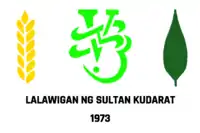 Flag  Seal | |
| Motto: SK Sikat Ka | |
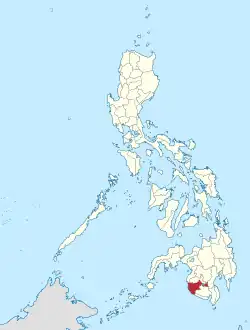 Location in the Philippines | |
OpenStreetMap | |
| Coordinates: 6°33′N 124°17′E | |
| Country | Philippines |
| Region | Soccsksargen |
| Founded | November 22, 1973 |
| Named for | Sultan Muhammad Dipatuan Kudarat |
| Capital | Isulan |
| Largest city | Tacurong City |
| Government | |
| • Type | Sangguniang Panlalawigan |
| • Governor | Datu Pax Ali S. Mangudadatu (Lakas–CMD) |
| • Vice Governor | Raden C. Sakaluran (Lakas–CMD) |
| • Legislature | Sultan Kudarat Provincial Board |
| Area | |
| • Total | 5,298.34 km2 (2,045.70 sq mi) |
| • Rank | 18th out of 81 |
| Highest elevation (Mount Pitot Kalabaw) | 1,503 m (4,931 ft) |
| Population (2020 census)[2] | |
| • Total | 854,052 |
| • Rank | 34th out of 81 |
| • Density | 160/km2 (420/sq mi) |
| • Rank | 56th out of 81 |
| Divisions | |
| • Independent cities | 0 |
| • Component cities | 1 |
| • Municipalities | |
| • Barangays | 249 |
| • Districts | Legislative districts of Sultan Kudarat |
| Time zone | UTC+8 (PHT) |
| ZIP code | 9800–9811 |
| IDD : area code | +63 (0)64 |
| ISO 3166 code | PH-SUK |
| Spoken languages | |
| Income classification | 1st class |
| Website | sultankudaratprovince |
On February 23, 1995, Sultan Kudarat transferred from Autonomous Region in Muslim Mindanao (now Bangsamoro Autonomous Region) to Soccsksargen.
Etymology
The name Sultan Kudarat given to the province was derived from the Maguindanaon Muslim ruler, Sultan Muhammad Dipatuan Kudarat who begun to assert his leadership in the year 1619 and reigned in the Sultanate of Maguindanao from 1625 to 1671. Through his leadership, Spanish forces were successfully repelled from encroaching the Cotabato region of south-central Mindanao.[3] He is considered a national hero, and in his honor the province was named after him.[4]
History
Sultan Kudarat was once part of the Sultanate of Maguindanao. It became one of the stronghold of the Maguindanao society as some royal families have established their own Sultanate in the region.
Sultan Kudarat was part of the former province of Cotabato, until its creation as an independent province (along with Maguindanao and North Cotabato) on November 22, 1973, through Presidential Decree No. 341.[5]
Palimbang massacre
One notable event that took place in Sultan Kudarat was the Palimbang Massacre (also called the Malisbong Masjid Massacre), which saw the mass murder of Moro residents of Barrio Malisbong in Palimbang by units of the Philippine Military on September 24, 1974,[6][7]–1,500[6] two years after Ferdinand Marcos declared martial law. Accounts compiled by the Moro Women's Center in General Santos state that 1,500 male Moros aged 11–70 were killed inside a mosque, 3,000 women and children aged 9–60 were detained – with the women being raped – and that 300 houses were razed by the government forces.[6]
Geography
Sultan Kudarat is situated on the southwestern section of central Mindanao. It is bounded on the north by the provinces of Maguindanao and Cotabato; on the south by South Cotabato and Sarangani; on the east by Davao del Sur; and on the west by the Moro Gulf and the Celebes Sea. The province's total land area is 5,298.34 square kilometres (2,045.70 sq mi).[8]
Two major mountain ranges encompass the province; the Alip Mountain Range in Columbio and the Daguma Mountain Range within the towns of Bagumbayan, Isulan and Esperanza.[9] The three coastal towns on the province's western side (Lebak, Kalamansig and Palimbang) are lined with mountain ranges that separate the central part of the province from the sea. There are also mountains on the eastern side, leaving flat land in between.[10]
The province has an irregular coastline of 132 kilometres (82 mi) in its three coastal towns, which face the Celebes Sea.[11] These coastal areas are prone to tsunamis coming from the Celebes Sea.[9] Approximately 2/3 of Lake Buluan's area is covered by the province in the towns of Lutayan and President Quirino. There are 7 major rivers within the province: Alip, Allah, Kapingkong, Tran, Salaman, Palimbang and Kabulnan. Additionally, there are 23 large creeks and 11 major springs within the province.[11]
Land use and soil types
Forestland constitutes majority of the province land use (50.32% ), followed by agricultural land (44.77%), fishing grounds (2.42%), non-agricultural land (1.16%), "other bodies of water" (1.02%), and fishponds (0.31%).[12]
Five major soil types are found within the province, majority of which is classified as Mountain Soil (71%), followed by Sandy Loam (12.036%), Silty Clay Loam (4.880%), Clay Loam (4.612%) and Loamy Sand (0.185).[13]
Climate
The climate of Sultan Kudarat falls under Type IV of Climate (characterized by rain showers or evenly distributed rainfall throughout the year). Heavy rainfall occurs from April to November. Unlike most other provinces in the country, Sultan Kudarat is generally free from typhoons as it is situated outside the "typhoon belt".[9]
The average temperature is 35 °C (95 °F), with 38 °C (100 °F) as the average maximum normally occurring in March. The lowest recorded was 18 °C (64 °F) in the Kulaman area in December to early January.[9]
Administrative divisions
Sultan Kudarat comprises 11 municipalities and 1 city. Three of the municipalities (Kalamansig, Lebak, and Palimbang) are coastal towns, while the rest of the province is located inland. The 11 municipalities and Tacurong City are further subdivided into 249 barangays.
Tacurong City is the smallest unit in the province by land area, but is the most urbanized and is considered the province's commercial center. Other growth centers are Lebak and Isulan, the latter being the provincial capital.

| |||||||||||||||||||||||||||||||||||||||||||||||||||||||||||||||||||||||||||||||||||||||||||||||||||||||||||||||||||||||||||||||||||||||||||||||||||||||||||||||||||||||||||||||||||||||||||||||||||||||||
Demographics
| Year | Pop. | ±% p.a. |
|---|---|---|
| 1918 | 37,439 | — |
| 1939 | 53,965 | +1.76% |
| 1948 | 4,784 | −23.60% |
| 1960 | 77,783 | +26.16% |
| 1970 | 191,315 | +9.41% |
| 1975 | 238,812 | +4.55% |
| 1980 | 303,784 | +4.93% |
| 1990 | 435,905 | +3.68% |
| 1995 | 522,187 | +3.44% |
| 2000 | 586,505 | +2.52% |
| 2007 | 677,062 | +2.00% |
| 2010 | 747,087 | +3.65% |
| 2015 | 812,095 | +1.60% |
| 2020 | 854,052 | +1.00% |
| Source: Philippine Statistics Authority[14][15][15] | ||
The population of Sultan Kudarat in the 2020 census was 854,052 people,[2] with a density of 160 inhabitants per square kilometre or 410 inhabitants per square mile.
At the 2000 census, the province had a total population of 586,505 inhabitants, which grew to 747,087 in the 2010 census. About 113 ethnic groups were identified in the province in the 2000 Census.[16] The Hiligaynons constitute the majority of the population,[16] with Hiligaynon being the province's most widely spoken language.[17] Other languages spoken in the province are Maguindanaon, Karay-a, Dulangan Manobo, Blaan, Teduray, Ilocano, and Cebuano.[9] Tagalog and English are also widely understood and used in education, business, and administration as the national official languages, the former being the secondary lingua franca in the province.
Aside from the Hiligaynons, who settled in Sultan Kudarat around the 17th to 18th centuries along with the Karay-as, whereas their fellow new settlers from Visayas continued until the Philippine independence, other ethnic groups in the province include the Maguindanaons (who constitute the majority of the provincial Muslim population), as well as the Manobos, Tedurays and Blaans, the three autochthonous ethnic groups of the province.[16] Ilocanos and Cebuanos meanwhile are relative newcomers to the province, with the former comprising the majority of the population in the towns of Lambayong and President Quirino, and the latter in the town of Kalamansig.
Religion
The four major religious groups in Sultan Kudarat are Catholicism (55.99%), Islam (22.88%), Evangelical (7.20%), and Iglesia ni Cristo (2.26%).[19] Other Christian groups constitute most of the remainders such as the Seventh-day Adventists, United Church of Christ in the Philippines, Jehovah's Witnesses, United Methodist Church, Southern Baptists, as well as "tribal religions".[20] In 2015 the Philippine Statistics Authority recorded Islam followed by 29.48% of the population.[21]
Economy

The economy of Sultan Kudarat is predominantly agricultural. The leading crops produced in the province are rice, corn, coconuts, coffee, bananas, mangoes, durians and African palm.[29] The province is self-sufficient in poultry, swine and root crops, and is one of the few producers of Irish potatoes in the Philippines. The southern Philippines Grain Complex in Tacurong is the largest grains-processing complex in the country. There are more than 200 rice mills in the province.
Fishing is an industry in the three coastal towns of the province (Kalamansig, Lebak and Palimbang).[30] Tuna caught along the coasts along the Celebes Sea are exported to Japan and Europe.
Other economic activities include cottage industries, which include crafts made of rattan and other types of wood.
Metallic minerals, which include copper, gold and silver, are found within the mountainous areas of Isulan, Bagumbayan, Sen. Ninoy Aquino, Palimbang and Columbio. Non-metallic minerals which include sand, gravel and marbleized limestone are also found in the province.[31]
Education
For the school year 2009–2010, the province has 475 schools (401 public and 74 private), 368 of which were elementary schools, 90 were secondary, and 17 were tertiary. Sultan Kudarat State University is the only public tertiary school within the province, with its main campus at Tacurong City. Its other campuses are situated in Bagumbayan, Isulan, Kalamansig, Lutayan, Palimbang, and Senator Ninoy Aquino.[32]
Health facilities
.jpg.webp)
In 2010, Sultan Kudarat had 27 hospitals (5 government-owned, 22 private and 1 mobile hospital), which are classified into 17 primary (6-25 beds capacity), 8 secondary (25-100 beds capacity) and 2 tertiary (over 100 beds capacity). Tacurong had the most number of hospitals in the province with 11, followed by Isulan with 5.[33]
Transportation
As of 2010, the provincial road network spanned a total length of 3,749.5813 kilometres (2,329.8818 mi) of which 49.26% were barangay roads, 27.97% provincial roads, 13.51% municipal/city roads and 9.25% national roads. Bagumbayan had the longest road network at 516.789 kilometres (321.118 mi), while Lutayan had the shortest at 107.38 kilometres (66.72 mi).[32]
Sultan Kudarat has two seaports: the Port of Lebak in Kalamansig and the San Roque Port in Palimbang, and four airports (2 government-owned: Lebak Municipal Airport and President Quirino Airport, and 2 privately owned: Kalamansig Airport and Kenram Airport).[34]
Government
.jpg.webp)
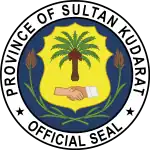
Elected Officials
The following are the elected government officials and their years of tenure:
|
Elected Officials (2016-2019):
Elected Officials (2010-2013):
Elected Officials (2007-2010):
Elected Officials (2004-2007):
|
Elected Officials (1998-2000; 2000–2004):
Elected Officials (1995-1998):
Elected Officials (1992-1995):
|
List of former governors
The former governors who have administered the province are:[35]
- Carlos B. Cajelo (Acting Governor) (November 23, 1973 — February 28, 1974)
- Gonzalo H. Siongco (Acting Governor) (March 1, 1974 — October 20, 1975)
- Conrado E. Buencamino (assumed as Governor) (October 21, 1975 — November 21, 1975)
- Benjamin C. Duque (Acting Governor) (November 22, 1975 — December 31, 1979); was elected Governor (January 1, 1980 — June 30, 1984)
- Aurelio C. Freires, Jr. (July 1, 1984 — March 19, 1986)
- Perfecto C. Bautista (assumed as Officer-In-Charge of the province) (March 20, 1986 — November 30, 1987)
- Fidel A. Fortez (designated as Officer-In-Charge) (December 1, 1987 — December 22, 1987)
- Exequiel S. Mayordomo (appointed as Officer-In-Charge) (December 23, 1987 — July 12, 1988)
- Nesthur R. Gumana (elected Provincial Governor) (July 13, 1988 — March 25, 1998)
- Rosila P. Jamison (March 26 – June 30, 1998)
- Pax S. Mangudadatu (July 1, 1998 — June 30, 2007)
- Suharto T. Mangudadatu (July 1, 2007 — June 30, 2016)
- Pax S. Mangudadatu (July 1, 2016 — June 30, 2019)
- Suharto T. Mangudadatu (July 1, 2019 — June 30, 2022)
Festivals

Festivals celebrated within the province include:
- Kalimudan — celebrated in the province of Sultan Kudarat, a gathering of ethnic groups within the province[36]
- Bansadayaw — celebrated in Bagumbayan[37]
- Kastifun — celebrated in Columbio[38]
- Hinabyog — celebrated in Esperanza[39]
- Hamungaya — celebrated in Isulan[40]
- Salagaan — celebrated in Kalamansig[41]
- Timpuyog — celebrated in Lambayong[42]
- Kapeonan — celebrated in Lebak[43]
- Kanduli — celebrated in Lutayan[44]
- Kalilang — celebrated in Palimbang[45]
- Sambuyawan — celebrated in President Quirino[46]
- Sulok — celebrated in Senator Ninoy Aquino[47]
- Talakudong — celebrated in Tacurong City[48]
Citations
- "List of Provinces". PSGC Interactive. Makati City, Philippines: National Statistical Coordination Board. Retrieved May 27, 2014.
- Census of Population (2020). "Region XII (Soccsksargen)". Total Population by Province, City, Municipality and Barangay. Philippine Statistics Authority. Retrieved July 8, 2021.
- "Manobo".
- Socio-Economic Profile of Sultan-Kudarat 2010, p. 1.
- "Presidential Decree No. 341: Creating the Provinces of North Cotabato, Maguindanao and Sultan Kudarat". Philippine Laws, Statutes & Codes. Chan Robles Virtual Law Library. November 22, 1973. Retrieved May 27, 2014.
- "1,500 Moro massacre victims during Martial Law honored". Mindanews. September 26, 2014. Retrieved May 24, 2016.
- Santos, Chyna (April 11, 2015). "Violence in Mindanao". The Guidon. Retrieved May 24, 2016.
- "Province: Sultan Kudarat". PSGC Interactive. Quezon City, Philippines: Philippine Statistics Authority. Retrieved January 8, 2016.
- Socio-Economic Profile of Sultan-Kudarat 2010, p. 8.
- Socio-Economic Profile of Sultan-Kudarat 2010, p. 5.
- Socio-Economic Profile of Sultan-Kudarat 2010, p. 6.
- Socio-Economic Profile of Sultan-Kudarat 2010, p. 34.
- Socio-Economic Profile of Sultan-Kudarat 2010, pp. 35–36.
- Census of Population (2015). "Region XII (Soccsksargen)". Total Population by Province, City, Municipality and Barangay. Philippine Statistics Authority. Retrieved June 20, 2016.
- Census of Population and Housing (2010). "Region XII (Soccsksargen)" (PDF). Total Population by Province, City, Municipality and Barangay. National Statistics Office. Retrieved June 29, 2016.
- Socio-Economic Profile of Sultan-Kudarat 2010, p. 11.
- Socio-Economic Profile of Sultan-Kudarat 2010, p. 9.
- "Archived copy" (PDF). Archived from the original (PDF) on April 24, 2016. Retrieved April 24, 2016.
{{cite web}}: CS1 maint: archived copy as title (link) - Socio-Economic Profile of Sultan-Kudarat 2010, pp. 10–11.
- "SocioEconomic Profile" (PDF). Journal. Province of Sultan Kudarat. 2010. Retrieved September 1, 2017.
- Philippine Statistics Authority (July 26, 2017). "Muslim Population in Mindanao (based on POPCEN 2015". Retrieved August 31, 2018.
- "Poverty incidence (PI):". Philippine Statistics Authority. Retrieved December 28, 2020.
- "Estimation of Local Poverty in the Philippines" (PDF). Philippine Statistics Authority. November 29, 2005.
- "2009 Official Poverty Statistics of the Philippines" (PDF). Philippine Statistics Authority. February 8, 2011.
- "Annual Per Capita Poverty Threshold, Poverty Incidence and Magnitude of Poor Population, by Region and Province: 1991, 2006, 2009, 2012 and 2015". Philippine Statistics Authority. August 27, 2016.
- "Annual Per Capita Poverty Threshold, Poverty Incidence and Magnitude of Poor Population, by Region and Province: 1991, 2006, 2009, 2012 and 2015". Philippine Statistics Authority. August 27, 2016.
- "Annual Per Capita Poverty Threshold, Poverty Incidence and Magnitude of Poor Population, by Region and Province: 1991, 2006, 2009, 2012 and 2015". Philippine Statistics Authority. August 27, 2016.
- "Updated Annual Per Capita Poverty Threshold, Poverty Incidence and Magnitude of Poor Population with Measures of Precision, by Region and Province: 2015 and 2018". Philippine Statistics Authority. June 4, 2020.
- Socio-Economic Profile of Sultan-Kudarat 2010, pp. 56–62.
- Socio-Economic Profile of Sultan-Kudarat 2010, p. 48.
- Socio-Economic Profile of Sultan-Kudarat 2010, p. 42.
- Socio-Economic Profile of Sultan-Kudarat 2010, p. 74.
- Socio-Economic Profile of Sultan-Kudarat 2010, p. 86.
- Socio-Economic Profile of Sultan-Kudarat 2010, p. 129.
- Socio-Economic Profile of Sultan-Kudarat 2010, pp. 1–2.
- Socio-Economic Profile of Sultan-Kudarat 2010, p. 220.
- Socio-Economic Profile of Sultan-Kudarat 2010, p. 221.
- Socio-Economic Profile of Sultan-Kudarat 2010, p. 222.
- Socio-Economic Profile of Sultan-Kudarat 2010, p. 223.
- Socio-Economic Profile of Sultan-Kudarat 2010, p. 224.
- Socio-Economic Profile of Sultan-Kudarat 2010, p. 225.
- Socio-Economic Profile of Sultan-Kudarat 2010, p. 226.
- Socio-Economic Profile of Sultan-Kudarat 2010, p. 227.
- Socio-Economic Profile of Sultan-Kudarat 2010, p. 228.
- Socio-Economic Profile of Sultan-Kudarat 2010, p. 229.
- Socio-Economic Profile of Sultan-Kudarat 2010, p. 230.
- Socio-Economic Profile of Sultan-Kudarat 2010, p. 231.
- Socio-Economic Profile of Sultan-Kudarat 2010, p. 232.
References
- "2010 Socio-Economic Profile; Sultan Kudarat Province" (PDF). Province of Sultan Kudarat. PPDO Staff. 2010. Retrieved April 24, 2016.
External links
 Media related to Sultan Kudarat at Wikimedia Commons
Media related to Sultan Kudarat at Wikimedia Commons Geographic data related to Sultan Kudarat at OpenStreetMap
Geographic data related to Sultan Kudarat at OpenStreetMap- Official website of the provincial government of Sultan Kudarat
- Local Governance Performance Management System
- Manila Statues: Sultan Kudarat Monument Information
